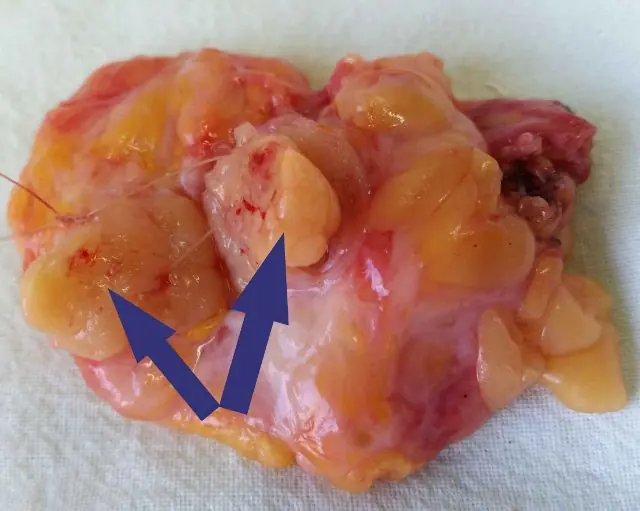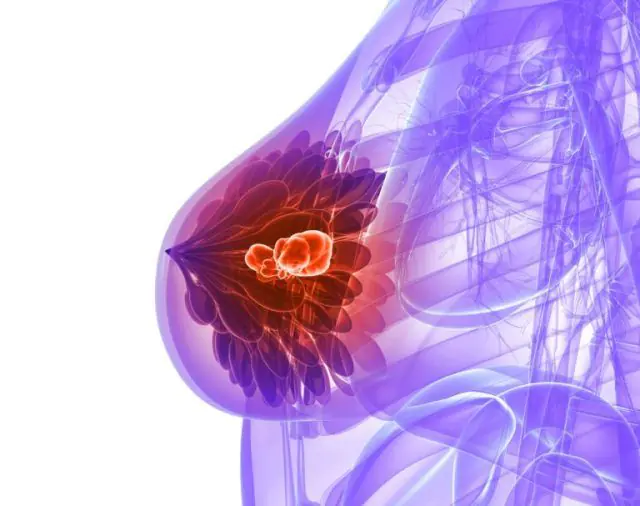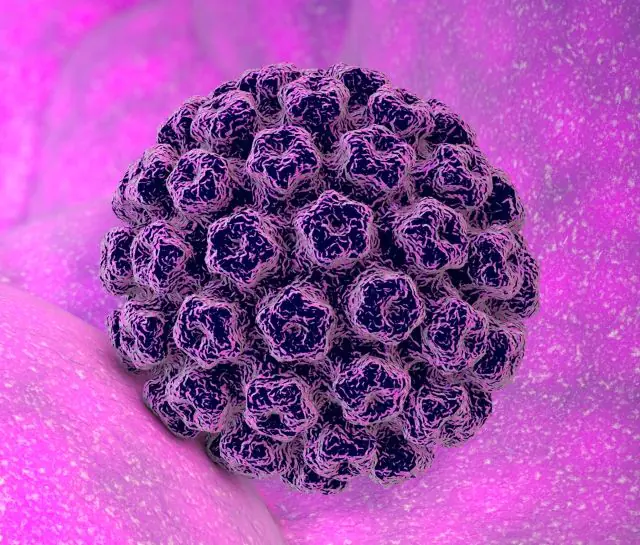
- What does intraductal papilloma of the mammary gland look like?
- Why do they appear?
- Diagnostic features
- Removal methods
Intraductal papilloma of the mammary gland is a formation of a benign nature, located in the lumens of the milk ducts in women. The growths can be single or numerous. With a large number of tumors in the ducts, doctors talk about papillomatosis. The disease can affect both young girls and mature women during menopause.
What does intraductal papilloma of the mammary gland look like?

The photo shows intraductal papilloma of the mammary gland
Intraductal benign neoplasms caused by HPV are also called cystadenomas, cystadenopapillomas. These are papillary growths that form from epithelial cells in the ducts of the patient’s mammary glands.
In terms of external signs, these neoplasms resemble cystic formations with an uneven surface in the form of small papillae. They can be found in different parts of the chest.
There are the following types of intraductal breast papilloma:
- Papillary. It can form in any part of the breast duct system. It can be areolar (areola area of the nipple), peripheral (lobe area), central (in the central part of the mammary glands).
- Intraductal. It can be large in size - up to several centimeters. May appear singular or form groups. Single growths affect the nipple area, multiple growths accumulate in the peripheral part of the breast lobes.
- Multiple cystadenomas. They can be localized in any part of the chest. These growths are more likely than others to become malignant and can cause the development of intraductal papillary oncology of the mammary glands.

Scheme of intraductal papilloma of the mammary gland
Typically, intraductal papillomas do not bother the patient for a long time. In the initial stages of the disease, only a specialist can detect a tumor through a thorough procedure of palpation of the chest. More often, growths in the periareolar zone are detected in this way. As a rule, there are no external manifestations - changes in the shape of the breast or epidermis.
The first noticeable signs of the disease appear when the neoplasm reaches a certain diameter and begins to put pressure on the lumens of the mammary gland ducts. The most obvious symptom of intraductal papilloma of the mammary gland is the discharge of a specific fluid from the nipple of a different color. They are reddish, whitish, yellowish, green, brown or transparent. Their shade depends on the presence of bleeding or the addition of a bacterial infection to the existing pathological process.
Also a symptom of intraductal papilloma is pain in the chest area, which increases with pressure or the use of tight underwear.
With the above signs, most often, it is already possible to palpate the tumor on your own. The easiest way to identify papilloma is that located in the nipple area. Upon palpation, an elastic nodule under the skin is determined. Moreover, it can decrease in size when you press on it, after which a certain amount of secretion comes out.
Quite often, intraductal papilloma of the mammary gland provokes activation of the inflammatory process, which involves neighboring healthy areas of the breast.The following signs are noted:
- Rapid increase in body temperature;
- Increased pain in the chest area;
- Redness on the epidermis in the area of papilloma formation;
- Tissue swelling and increase in size of the affected mammary gland;
- Change in the shade of the secretion discharged from the nipples (reddish, greenish, brown);
- Pus from the nipples with worsening inflammation and the addition of a bacterial infection.
A pronounced inflammatory process can be accompanied by intoxication of the body, which is manifested by weakness, apathy, and headaches.
Why do intraductal papillomas appear?

Any papillomas are the result of the activity of papillomavirus in the body. But the formation of intraductal papilloma of the mammary gland is by no means necessary when infected with HPV.
Factors that contribute to the development of such pathology may include:
- Hormonal imbalance. Concomitant diseases in this case include adnexitis, polycystic ovary syndrome, and oophoritis.
- Frequent artificial or spontaneous terminations of pregnancy - abortion, miscarriage.
- Metabolic problems. This manifests itself in the form of obesity of various stages.
- Fibrous cystic mastopathy. This pathology causes local dilation of the breast ducts. Papillomatous growths form in them.
- Tumor neoplasms on the internal genital organs - uterine fibroids, chorionepithelioma.
- Genetic predisposition. Many women who develop intraductal papilloma of the breast have a family history of tumor lesions of the mammary glands of a benign or oncological nature.
- Previously undergone surgical interventions on the mammary glands.
- Chronic diseases of the endocrine system, thyroid gland.
- Frequent stress, overwork, chronic fatigue.
- Menopause, menopause.
Also in the potential risk category are women who lead an unhealthy lifestyle - smoking, drinking alcohol. Less commonly, intraductal papilloma occurs due to a general decrease in immunity.
- See also the reasons for the occurrence of intraductal papilloma during pregnancy
Features of diagnosis of intraductal papilloma of the mammary gland

An initial examination in a mammologist’s office often does not make it possible to establish an accurate diagnosis and identify intraductal papilloma. Therefore, if a neoplasm of unknown nature is suspected in the breast, the specialist will refer the woman for a more detailed examination.
Instrumental techniques prescribed for suspected mammary papillomatosis may be the following:
- Mammography. X-ray of the thoracic ducts, which can detect tumors in the mammary glands. In some cases, this procedure may be inaccurate in young girls who have higher breast tissue density. For this reason, mammography is an effective screening method for women over 40 years of age.
- Ultrasound of the mammary glands. This procedure allows you to identify tumors with a diameter of 5 mm or more. Ultrasound examination is quite informative, as it makes it possible to determine the structural structure of the tumor and differentiate cysts and intraductal papillomas. Ultrasound also allows you to examine the nearest lymph nodes and identify their damage, if any.
- Ductography. This is a type of radiography in which a bright coloring substance enters the blood. Currently, this diagnostic procedure is as informative as possible. It allows not only to identify neoplasms in the breast tissue, but also the condition of all ducts. This type of diagnosis of intraductal papilloma involves injecting a contrast liquid through the nipple through a catheter. After this, radiography is performed. The photographs taken make it possible to determine the location of the intraductal papilloma and the risk of its malignancy.
- MRI. Another accurate diagnostic procedure that allows you to identify a neoplasm, its structure and location. In this case, the patient is not exposed to radiation.
- Cytological examination of a nipple smear. This analysis allows us to determine the presence of cellular atypia and provides preliminary results about the nature of the neoplasm.
- Tumor marker CA 15-3. This is a blood test that is performed if malignancy of intraductal papilloma of the mammary gland is suspected. It makes it possible to determine the nature of the tumor in the chest without performing a traumatic biopsy.
In addition, a woman must undergo a general and biochemical blood test. Only after collecting all the data from tests and studies can a specialist make a correct diagnosis.
Methods for removing intraductal breast papilloma

Based on the fact that intraductal papilloma of the breast is considered a precancerous pathology of the mammary glands, most specialists are inclined to surgical treatment of the disease. Papilloma inside the breast very rarely resolves spontaneously or under the influence of antitumor drugs, so in order to avoid complications and malignancy of the tumor, it should be removed.
During such radical treatment, all affected tissue is removed. Many patients are afraid of aesthetic changes in the breasts. However, modern surgery allows for the most gentle operation with minimal consequences.
Removal of intraductal papilloma is performed using the technique sectoral resection. In this case, part of the breast is removed in the form of a sector containing pathological tissue. This operation is performed under general anesthesia.
The procedure begins with marking the chest with a special pencil. Next, skin incisions are made in the radial direction from the areola. The doctor also makes another incision from the edges of the tumor to the large chest muscle. The epidermis is separated from the tissues, and the tumor is excised. The sample is sent for histology.
Before applying sutures with self-absorbing threads, electrocoagulation of the vessels is performed, as well as sanitation of the wound. The doctor closes the surgical area and stitches it up in layers. At the end of the operation, drainage is installed for 2-3 days.
This method of surgical intervention is gentle and rarely leaves behind traces, scars, or deformations of breast tissue. Mammoplasty after sectoral resection is extremely rarely required.
If a woman develops intraductal papillary cancer, it is recommended that she radical mastectomy. During this operation, the entire affected organ and nearby lymph nodes are removed. This procedure is also carried out in the case of multiple intraductal breast papillomas, which are distributed along the periphery of the organ.
After removal of the tumor, the patient is prescribed bed rest and drug treatment. As a rule, antibacterial drugs are prescribed to avoid the development of bacteriological infection. Also, if there is a hormonal imbalance, hormonal therapy is recommended.
The treatment of intraductal papilloma should be approached with all responsibility, since this pathology can easily develop into cancer. In this case, the prognosis is less favorable, and therapy is longer and more painful.
- See also recipes for folk remedies for intraductal papilloma of the mammary gland
How to remove intraductal papilloma of the mammary gland - watch the video:
Intraductal papilloma of the breast is a serious disease that is provoked by the papillomavirus. In this case, lesions of the mammary glands can be single or multiple. Only a specialist mammologist can establish a correct diagnosis through instrumental examinations and special blood tests and smears. Self-medication of this pathology is strictly not recommended.
- Related article: Which doctor should I contact for papillomas?



